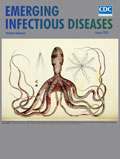
Volume 26, Number 8—August 2020
Dispatch
Autochthonous Gnathostomiasis in Madagascar
Annie Raharisoa1, Arezki Izri1, Romain Lovanirina Andrianjafy, Ranto Andriantsilavina Rajaona, Anthony Marteau, Remy Durand, and Mohammad Akhoundi
Abstract
We used molecular tools to identify an autochthonous case of gnathostomiasis in Madagascar. This severe ocular infection, caused by Gnathostoma spinigerum nematodes, led to vision loss in the patient’s left eye. Clinicians should be aware of this parasitosis in Madagascar and other countries in Africa.
Human gnathostomiasis is a foodborne parasitic zoonosis caused by spiruroid nematodes of the genus Gnathostoma (1). There are 13 species of Gnathostoma, including 6 from Asia and 7 from the Americas. Of these species, 4 (G. spinigerum, G. hispidum, G. doloresi, and G. nipponicum) in Asia and 1 (G. binucleatum) in Latin America are pathogenic to humans (2). The life cycle of the parasite requires >3 hosts, some of which might be paratenic. Host species vary depending on the Gnathostoma species; for most Gnathostoma species, humans are accidental dead-end hosts. Ingestion of the third larval stage of Gnathostoma spp. in raw or undercooked freshwater fish, eels, frogs, reptiles, or birds results in cutaneous, and sometimes visceral, larva migrans. Other proposed routes of infection include drinking water contaminated with infected Cyclops spp. crustaceans and transcutaneous penetration during the preparation of contaminated food (3). Clinical signs and symptoms of infection depend on the affected organ(s) (3,4), which might include the skin; gastrointestinal or genitourinary tracts; lungs; and, more rarely, the central nervous system and the eyes (5). Infection results in nonspecific signs and symptoms, such as fever, urticaria, anorexia, nausea, vomiting, and diarrhea, accompanied by larval migration; in the case of central nervous system involvement, infection can be fatal (3). Painful or pruritic migratory subcutaneous edema is the most common symptom of Gnathostoma infection. Physicians diagnose gnathostomiasis on the basis of eosinophilia, migratory lesions, and the patient’s history of geographic and dietary exposures (6).






















.png)











No hay comentarios:
Publicar un comentario